|
< Earlier Kibitzing · PAGE 2 OF 2 ·
Later Kibitzing> |
| Apr-03-14 | | zb2cr: 37. Rh6+, Kxh6; 38. Qh8+. Now, if
38. ... Kg5, 39. Qxg7+, Kf4; 40. Qc7+ winning the Queen. If Black tries 39. ... Kh4??; 40. Qh6#.So Black is forced to play 38. ... Rh7; 39. Qf6+, Kh5; 40. Bd1+ with mate next move. |
|
| Apr-03-14 | | Memethecat: Black threatens mate on g2 or draw by rep, 38.Bxd5 is surely winning, but I think the tactical trick 38.Rh6 is more suited to a Thursday puzzle. 37.Rh6+ Kxh6
38.Qh8+ Kg5 (...Rh7 39.Qf6+ Kh5 40.Bd1+ Qg4/f3 41.Bxg4/f3#) 39.Qxg7+ Kf4
40.Qxg3 Kxg3
41.f6 Be8
42.Bxd5 and it's all over. |
|
| Apr-03-14 | | Memethecat: Mmm.. Looks like I was the only one that missed 40.Qc7+. A neater finish! |
|
| Apr-03-14 | | patzer2: Beginning with 37. Rh6+!, I saw through to the game finish of today's Thursday puzzle. However, I made the solution more difficult than necessary by missing the best move after 37. Rh6+!, Kxh6; 38. Qh8+ Kg5 39. Qxg7+, Kf4 (Position below). 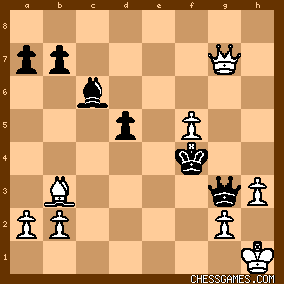
click for larger viewHere it's clear the easy solution is the skewer 40. Qc7+!, winning the Queen after 40...Kxf5 41. Qxg3  . . But I didn't calculate this before deciding on 37. Rh6+!, and instead found myself working out the endgame win after 40. Qxg3 Kxg3 41. f6  . This longer route wins, but it's frustrating not seeing 40. Qc7+! four moves ahead. . This longer route wins, but it's frustrating not seeing 40. Qc7+! four moves ahead. |
|
| Apr-03-14 | | Lambda: There is no real difference between 40.Qc7+ and 40.Qxg3+. Both are clear and certain ways of getting to a trivial win. Once you've seen either, there is no point looking for the other. |
|
| Apr-03-14 | | awfulhangover: I often struggle with Thursday puzzles. Today I got it correct in 20 seconds. It looked forced! |
|
| Apr-03-14 | | Memethecat: <Lamdba> Yes, but in that case 37.Bxd5 is a simple win too.
I understand how <patzer2> feels, these puzzles are about improving your visualization and tactical ability. I only get that warm feeling of satisfaction when I've seen all there is to see. |
|
Apr-03-14
 | | paulalbert: I didn't see the much better Qc7+ variation either in my calculations; saw that the Qxg3+ variation leads to an easily won endgame so that was all I needed to go with Rh6+ in the puzzle position. Would I have seen it had we gotten to the actual position while playing? I hope so, but easy to get fixated on a clearly winning line without looking further; from what I see in GMs' annotations of their own games, it happens to them too, and then some amateur shows them a better move after the game is over. It's hard to follow Emanuel Lasker's admonition: See a good move, stop, look for a better one! |
|
| Apr-03-14 | | Cheapo by the Dozen: White is two pawns up, but has difficulty stopping mate. And 37 Rg6, which does stop most of the mate threats, allows perpetual check. So something forcing is needed. And that would be: 37 Rh6+ Kxh6
38 Qh8+ Rh7
39 Qf6+ Kh5
40 Bd1+ (Black cries)
I see one serious try for Black to deviate, namely via 38 ... Kg5, but that leads to: 37 Rh6+ Kxh6
38 Qh8+ Kg5
39 Qxg7+ Kf4
40 Qxg3 Kxg3
41 f6 Be8
42 Bxd5 (Black cries) |
|
Apr-03-14
 | | Sally Simpson: Hi Cheapo.
Look at patzer2's post above, he even supplies a diagram.
There is a better move than 40.Qxg3+ in your second variation. (you have Black crying two moves earlier.) |
|
| Apr-03-14 | | JohnBoy: This was fun - nice pick for PotD. |
|
| Apr-03-14 | | beenthere240: If all you see when facing move 36 is the combination ending with 40. Qxg3 and an easily won endgame, then you can start with 36. Rxh6+ with confidence. However you can still check each move before you make it and I'll be OTB you'll find 40. Qc7+ then. The best of these puzzles are like studies in that the deeper you look into them, the more you can discover. |
|
| Apr-03-14 | | abuzic: Both players went wrong several times in the course of this game: After black's <23...Nd5?> 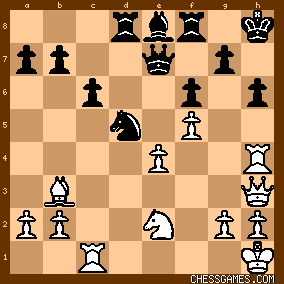
click for larger viewwhite could win with
24.♙ex♙d5 ♕xe2 25.♖xh6+ ♙gx♙h6 <25...Kg8 26.Rh8+ Kf7 27.d6+ and mate next> 26.♕xh6+ ♔g8 27.♙d6+ ♗f7 <27...Rf7 28.Qxf6 wins> 28.♕g6+ ♔h8 29.♕xf6+ ♔h7 <29...Kg8 30.Qg6+ Kh8 31.Qh6+ Kg8 32.f6 Qg4 33.Bc2 a mating attack> 30.♗xf7 ♕g4 31.♖e1, with many threats like ♙d7, ♗g6+, ♕e7, ♙h3 black has no defence On move <33>:

click for larger view?Why didn't white play 33.♘xg7 ♕xg7 34.♕f4 with clear winning position?;

click for larger view
because after <33.Re6> ♖h7 34.♘xf6+ ♕xf6 35.♕xf6 ♖xf6 36.♖xf6
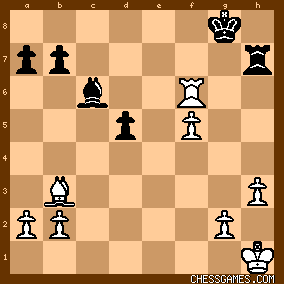
click for larger view
although the position favors white, black still has chances of draw. |
|
Apr-03-14
 | | keypusher: Always easier to solve a puzzle when the other side is threatening mate. |
|
| Apr-03-14 | | kevin86: This looks easy for a Thursday; white is threatened with mate so 37 ♖h6+ ♔xh6 38 ♕h8+ and white wins the queen or mates |
|
| Apr-03-14 | | James D Flynn: 37.Rh6+ Kxh6 38.Qh8+ Rh7(if Kg5 39.Qxg7+ Kf4 41.Qxg3+ Kxg3 42.f6 Bf1 43.Bxd5 wins the Black B for the White f pawn with an easily won endgame) 39.Qf6+ Kh5 40.Bd1+ and Black must give up the Q to delay mate for one move only. |
|
Apr-03-14
 | | Phony Benoni: Got a little more information. White is <Anthony Dod>, player, problem composer and a long-time member of the Liverpool Chess Club beginning in 1887/88. The game was played in the third annual match between the Northern Counties Chess Assocatioin and the Scottish Chess Associatioin, held May 30, 1903, at Ferguson & Forrester's Restaurant, 129 Princess Street, Edinburgh. (British Chess Magazine, 1903, p.309). Dod's opponent was no slouch. Mills was an eight-time Scottish Championn. To be paired up with him, Dod must have had a decent reputation. |
|
| Apr-03-14 | | BOSTER: The same <trick >sometimes played Korchnoy. What is not clear why POTD began with move
37., not 36. |
|
| Apr-03-14 | | Cheapo by the Dozen: Yep. As noted above, I missed the skewer. Also as noted above -- who cares? I think we all would have gotten this right over the board. Tougher would have been getting to the puzzle position in the first place. |
|
| Apr-03-14 | | Cheapo by the Dozen: Wait -- let me amend that. I care because somebody showed me a better move, and better yet it was a cool one. :) But we can feel we solved the puzzle w/o seeing the best win in every future position. |
|
| Apr-03-14 | | TheBish: A Dod vs D Mills, 1903 White to play (37.?) "Medium"
White is down two pawns and is facing mate, but has the move and a winning attack: 37. Rh6+! Kxh6 38. Qh8+ Kg5
Or 38...Rh7 39. Qf6+ Kh5 40. Bd1+ and mate next.
39. Qxg7+ Kf4
Or 39...Kh4 40. Qh6#.
40. Qc7+ and the skewer will win Black's queen. |
|
| Apr-03-14 | | Patriot: 37.Rh6+ Kxh6 38.Qh8+
38...Rh7 39.Qf6+ Kh5 40.Bd1+ 
38...Kg5 39.Qxg7+ Kf4 40.Qc7+ 
38...Kg5 39.Qxg7+ Kh4 40.Qh6# |
|
Apr-04-14
 | | LIFE Master AJ: Part one (analysis) of the POTD for Thursday.
A Dod - Daniel Yarnton Mills
[D60]
North vs. North (Match)
Scotland, 1903 / [A.J.G.]
A quick look at this game.
1.d4 d5; 2.c4 e6; 3.Nc3 Nf6; 4.Bg5 Be7; 5.Nf3 Nbd7; 6.e3 0-0; Thus far, it is a relatively normal <("Book")> line ... the Queen's Gambit Declined. Please see:
Opening Explorer for more on this opening. (See also - may page: http://www.angelfire.com/games3/lif..., for a fairly detailed overview of the whole of the QGD.) 7.Bd3!?,
This should lose time to the immediate capture on the c4-square, better is the main line of 7.Rc1. [ Probably better was: 7.Rc1, 
[See MCO-15, beginning on page # 389.] ]
7...c6; 8.0-0 dxc4; 9.Bxc4 Nd5; 10.Bxe7 Qxe7; 11.e4, (Maybe - '!') This is a very energetic move, which I like.
[ The "Power-Book" prefers 11.Rc1,  although I am not 100% sure that this is any better than e4. ] although I am not 100% sure that this is any better than e4. ] 11...N5b6!?; (tempo-loss)
This leaves Black cramped.
[With a badly congested position - it is (now) very difficult for the second player to get his LSB into the game anytime soon.] 
click for larger view I don't think any modern player would play the QGD in this fashion. [ Definitely better was: >/= ¹11...Nxc3! ; 12.bxc3,  12...e5!?;
which is the "book" line, although White still has a definite edge here. ] 12...e5!?;
which is the "book" line, although White still has a definite edge here. ] I think that White's next move is best, after Black plays ...e5; and we have exchanges in the center, White's LSB will be aimed directly at the Black King. 12.Bb3! e5; 13.Nxe5 Nxe5; 14.dxe5 Qxe5; 15.f4!?, A very reasonable move, however, the engines choice of Qd3! is just a little more accurate.
(White can then play Bc2, and then f4.)
15...Qc5+; 16.Kh1 Kh8;
Maybe (also) a little inaccurate, 16...Be6!; was necessary here. *** *** *** *** *** ***
Now 17.e5! would have given White a nice (comfortable) edge, with a sharp position that definitely favors White. Dod now begins a logical assault on the BK, which is the natural outgrowth of White's King-side edge in space, mobility and the Pawn majority on that side of the chess board. 17.Rc1 Qe7; 18.f5!? f6; 19.Rf4 Bd7; 20.Qh5 h6; 21.Ne2 Be8; 22.Qh3 Rd8?; While this might appear to be a fairly normal move, in reality, this was a mistake. [ A definite improvement was: >/= ¹22...Bf7 ▢; ('!') 23.Rh4 Bxb3; 24.Qxb3,  24...Qf7; etc.
(White may have a small edge, but Black's position is OK & fully playable.) ] 24...Qf7; etc.
(White may have a small edge, but Black's position is OK & fully playable.) ] 23.Rh4 Nd5?; (ooops)
Black was in a bad way ... but this should have only made things a lot worse. [>/= 23...Kh7▢; 24.Nf4 Bf7; 25.Ng6,  ] ] 24.Rxh6+?!, (Maybe - '?')
While this looks promising, it is completely unnecessary, as there was a solution to this position - which would leave White just a piece ahead. [ The simplest line is: >/= ¹24.Nc3 Bf7▢; <(Black gets shelled after: ‹24...Nxc3?; 25.Rxh6+! gxh6▢; 26.Qxh6+ Qh7▢; 27.Qxf8+ Qg8▢; 28.Qxg8#. )> 25.exd5 cxd5!?; 26.Rd4,  with an easy win for White. ] with an easy win for White. ] |
|
Apr-04-14
 | | LIFE Master AJ: Part Two - of my analysis.
24...gxh6; 25.Qxh6+ Kg8;
Thus far, White has pursued his attack. And while the 1st party may have not played perfect chess, most of his moves have been pretty good, all things considered. 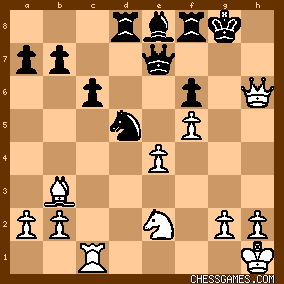
click for larger view This is the current position ... (just above).
26.Rc3!?, (Rook-luft.)
While this is an interesting idea, it was clearly not the best continuation for White. [ Better was: >/= 26.exd5 cxd5; 27.Nf4‚ "--->" (With a strong attack.) - Houdini 3.0 Also an improvement over the game would have been:
>/= 26.Nf4 Qxe4; 27.Ne6 Rf7; 28.Nxd8 Rg7; 29.Qh3 ± , (adv./White)
when - again - the first player is clearly better. - Fritz 13. ] 26...Rf7 ▢; 27.Rg3+!?, (hmmm)
This move is a natural follow-up to the Rc3 idea, but White actually had a superior move to Rg3.
(See the analysis - just below. If this is true, then the question begs itself - why is the capture on d5 superior to the rook-check on g3? I think the answer is that White wants the B♖ on f7, as it is a target to attack.) [ Clearly better was: >/= ¹27.exd5! cxd5; 28.h3, " ∞ " (unclr)
when play is approximately balanced here - White may even be a little bit better. ( - Fritz 13 and Houdini 3.0) ] The next few moves seem to be all best or forced - for both sides. 27...Rg7; 28.exd5 cxd5; 29.Re3, "="
Play so far has balanced itself out, Black has a slight material advantage, while White has much better piece play. Now Black should play his Rook to h7, when Qf4, Qc7; is essentially a balanced position. 29...Qf7?; 30.Nf4 Rc8!?; 31.h3 Bc6!?; 32.Nh5 Rf8[]; Black's last move was forced.
Now ♘x♖/g7, followed by Qf4 (  ) is a simple win for the first player.
(After 33.Re6!?, Black should play 33...Rh7[]. Then White missed 34.Re4!, with an overwhelming game; Dod would have had the threat of NxR/g7, to be followed by Rg4, winning Black's Queen.) ) is a simple win for the first player.
(After 33.Re6!?, Black should play 33...Rh7[]. Then White missed 34.Re4!, with an overwhelming game; Dod would have had the threat of NxR/g7, to be followed by Rg4, winning Black's Queen.) 33.Re6!? Qc7?; 34.Nxf6+? Rxf6; 35.Qxf6 Qg3?; ('??') This looked great, as Black threatened a mate-in-one on the g2-square ... but it fails to a simple combination. [ Better was: >/= 35...Qf4▢; but then White plays: 36.Re1 ,  and the first player is much better, and probably winning, but this is still superior to what occurred in the game. ]
and the first player is much better, and probably winning, but this is still superior to what occurred in the game. ] 36.Qd8+! Kh7▢;
Black had no choice here.
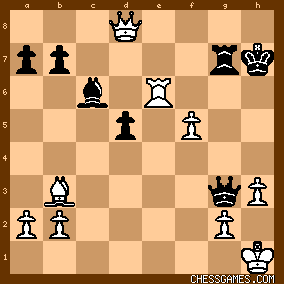
click for larger viewNow we have (finally) reached the position for the POTD for Thursday; April 3rd, 2014. [ The end is abrupt after: ‹36...Kf7?; 37.Rf6#. ] 37.Rh6+! Kxh6▢;
This was Black's only legal move here.
38.Qh8+ Rh7!?; (hmmm)
Technically - this move is an error ... but only according to a chess engine. (A human will resign before just mindlessly throwing around material ... playing "give-away.") [ The box says the following line is best/forced: >/= 38...Kg5[]; 39.Qxg7+,  when Black must lose his Queen, no matter what. ] when Black must lose his Queen, no matter what. ] 39.Qf6+ Kh5▢;
This is forced, if the Queen goes to g6, then QxQ/g6# is just a mate here. 40.Bd1+, '  ' Black Resigns. ' Black Resigns.
A mate is on the board after ...♕f3▢; (and now) 41.♗x♕f3#. 1 - 0 |
|
| Apr-04-14 | | newzild: <<chrisowen> an gog queen flogger trig as am choose a wave in blew away e6 over h6 as head heals no rift g7 in mixed fortunes comes off a cropper h8 accent refine curious to see frees flat of the land affable mission selects I cross fading a nest in bet swamp am germane family inch along h6 deriguer one forgo getter one forlorn 37.Rh6+!>
Certainty? Retilinear intransigence re 37. Rh6+?? implements rock-solid impudence via wafty square access kingside. Ask any marmot. |
|
 |
|
< Earlier Kibitzing · PAGE 2 OF 2 ·
Later Kibitzing> |
|
|
|





